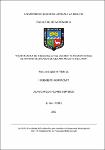Mostrar el registro sencillo del ítem
Resistencia de Tetranychus urticae (Acari : Tetranychidae al Spirodiclofen en el departamento de Lima
| dc.contributor.advisor | Vásquez Castro, Javier Alberto | |
| dc.contributor.author | Flores Bernedo, Juan Carlos | |
| dc.date.accessioned | 2020-08-18T02:55:07Z | |
| dc.date.available | 2020-08-18T02:55:07Z | |
| dc.date.issued | 2020 | |
| dc.identifier.uri | https://hdl.handle.net/20.500.12996/4407 | |
| dc.description | Universidad Nacional Agraria La Molina. Facultad de Agronomía. Departamento Académico de Entomología | es_PE |
| dc.description.abstract | Se evaluó la resistencia se Tetranychus urticae (C.L. Koch, 1836) al acaricida Spirodiclofen, mediante la realización de bioensayos toxicológicos bajo condiciones de laboratorio. En la presente investigación se colectaron individuos adultos de T. urticae procedentes de campos de fresa de los distritos de Aucallama, Chancay, Huaral y Santa Rosa de Quives en el departamento de Lima. Se utilizó como raza susceptible de referencia a una población procedente del campus de la Universidad Nacional Agraria La Molina (UNALM), colectada en plantas de Acalypha wilkesiana, de donde se tiene la certeza de no haberse realizado aplicaciones químicas. Las muestras de ácaros se trasladaron al Laboratorio de Toxicología de la UNALM, donde se sometieron a bioensayos para determinar la susceptibilidad al Spirodiclofen. En primer lugar, se estimó la CL50 y CL95 en la raza susceptible de referencia. Luego se aplicaron dichas concentraciones sobre las poblaciones de campo estudiadas. Posteriormente, los resultados fueron sometidos al análisis de varianza y comparación de medias por el método Tukey (α=0,05). Las cuatro poblaciones evaluadas no mostraron diferencias estadísticamente significativas frente a la CL50 y CL95 establecidas para la población susceptible, lo cual sugiere que las poblaciones estudiadas de T. urticae son susceptibles al Spirodiclofen, no evidenciándose problemas de resistencia. Es por ello que se recomienda el uso de Spirodiclofen como una herramienta para el control de T. urticae en dichas locaciones al ser susceptible a este ingrediente activo. | es_PE |
| dc.description.abstract | Tetranychus urticae (C.L. Koch, 1836) resistance to Spirodiclofen acaricide was evaluated by performing toxicological bioassays under laboratory conditions. In the present investigation, adult individuals of T. urticae were collected from strawberry fields in the districts of Aucallama, Chancay, Huaral and Santa Rosa de Quives in the department of Lima. It was used as a susceptible breed of reference to a population from the campus of the National Agrarian University La Molina (UNALM), collected in Acalypha wilkesiana plants, where it is certain that no chemical applications have been made. The mite samples were transferred to the UNALM Toxicology Laboratory, where they underwent bioassays to determine susceptibility to Spirodiclofen. First, the LC50 and LC95 were estimated in the susceptible reference breed. These concentrations were then applied to the field populations studied. Subsequently, the results were subjected to analysis of variance and comparison of means by the Tukey method (α=0,05). The four populations evaluated showed no statistically significant differences against the LC50 and LC95 established for the susceptible population, which suggests that the studied populations of T. urticae are susceptible to Spirodiclofen, with no evidence of resistance problems. That is why it is recommended to use Spirodiclofen as a tool for the control of T. urticae in these locations, being susceptible to this active ingredient. | en_US |
| dc.format | application/pdf | en_US |
| dc.language.iso | spa | es_PE |
| dc.publisher | Universidad Nacional Agraria La Molina | es_PE |
| dc.rights | info:eu-repo/semantics/openAccess | en_US |
| dc.rights.uri | https://creativecommons.org/licenses/by-nc-nd/4.0/ | * |
| dc.subject | Tetranychus urticae | es_PE |
| dc.subject | Spirodiclofen | es_PE |
| dc.subject | Resistencia a productos químicos | es_PE |
| dc.subject | Control químico | es_PE |
| dc.subject | Enfermedades de las plantas | es_PE |
| dc.subject | Control de las enfermedades | es_PE |
| dc.subject | Perú | es_PE |
| dc.subject | Resistencia química | es_PE |
| dc.title | Resistencia de Tetranychus urticae (Acari : Tetranychidae al Spirodiclofen en el departamento de Lima | es_PE |
| dc.type | info:eu-repo/semantics/bachelorThesis | en_US |
| thesis.degree.discipline | Agronomía | es_PE |
| thesis.degree.grantor | Universidad Nacional Agraria La Molina. Facultad de Agronomía | es_PE |
| thesis.degree.name | Ingeniero Agrónomo | es_PE |
| dc.subject.ocde | http://purl.org/pe-repo/ocde/ford#4.01.07 | es_PE |
| renati.author.dni | 74994663 | es_PE |
| dc.publisher.country | PE | es_PE |
| dc.type.version | info:eu-repo/semantics/publishedVersion | en_US |
| renati.advisor.orcid | https://orcid.org/0000-0003-3407-6938 | es_PE |
| renati.advisor.dni | 32942489 | es_PE |
| renati.type | https://purl.org/pe-repo/renati/type#tesis | es_PE |
| renati.level | https://purl.org/pe-repo/renati/level#tituloProfesional | es_PE |
| renati.discipline | 811036 | es_PE |
| renati.juror | Soplín Villacorta, Hugo | |
| renati.juror | Joyo Coronado, Germán Elías | |
| renati.juror | Castillo Valiente, Jorge Ramón |
Ficheros en el ítem
Este ítem aparece en la(s) siguiente(s) colección(ones)
-
AGR-EN Tesis [99]



